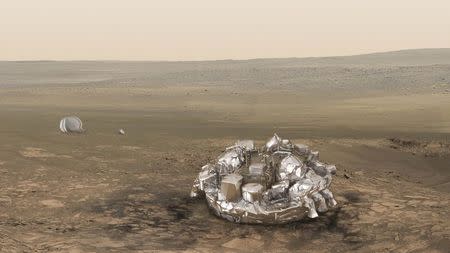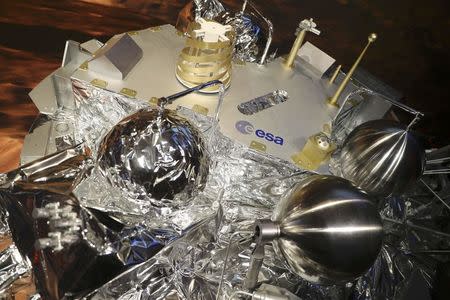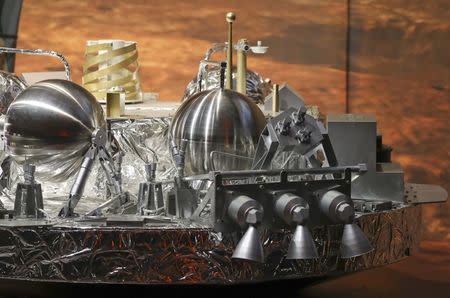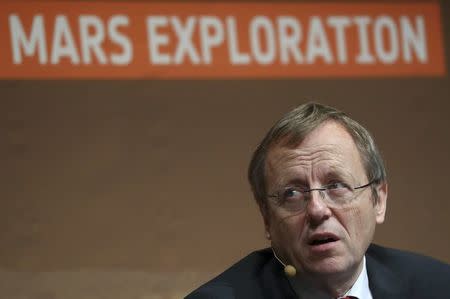Crash landing feared as Europe's Mars lander still silent
FRANKFURT/BERLIN (Reuters) - Thrusters intended to slow a European lander as it neared Mars on Wednesday fired for less time than expected before contact with the vehicle was lost, leaving scientists uncertain whether it touched down safely or broke apart. The Schiaparelli probe, part of a broader mission to search for evidence of life on the Red Planet, was to test technologies during the descent and on the surface for a rover scientists hope to send to Mars in 2020. Its descent marked only the second European attempt to land a craft on Mars, but it has shown no signs of life since it stopped transmitting around 50 seconds before Wednesday's planned touchdown. "We've had two over flights (by Mars orbiters) and there was no signal," the European Space Agency's (ESA) Spacecraft Operations Manager Andrea Accomazzo told journalists on Thursday. The disc-shaped 577-kg (1,272 lb) Schiaparelli is part of the Russian-European ExoMars program that is seeking signs of life. The primary part of the mission this year, bringing the Schiaparelli lander's mothership into orbit around Mars, was meanwhile a success. That craft, called Trace Gas Orbiter, will use an atmospheric probe to sniff out methane and other gases around Mars linked to organic life. It will also act as a data relay station for the rover, which is due to follow in 2020. Landing on Mars, Earth's neighbor and at its closest some 35 million miles (56 million km) away, is a notoriously difficult task that has thwarted most Russian efforts and given NASA trouble as well. The U.S. space agency had a setback of its own on Wednesday. Its Juno spacecraft lost its main computer and science instruments shortly before it was due to make an orbital pass near Jupiter, scuttling highly anticipated close-up observations of the largest planet in the solar system. LAST FEW SECONDS Schiaparelli is supposed to test new technologies for a rover that will be the first with the ability to both move across the surface of Mars and drill into the ground to collect and analyze samples. Scientists said they had received data from the lander covering its entry into the Martian atmosphere and the deployment of its heat shield and parachute, which were designed to slow it from a speed of 21,000 km per hour. But its thrusters appeared to have fired for only a few seconds, much shorter than expected, and scientists are not sure how far off the ground Schiaparelli was when they shut off. "We need to understand what happened in the last few seconds before the planned landing," said David Parker, ESA's Director of Human Spaceflight and Robotic Exploration. Scientists will analyze all the data received so far, and also still hope to re-establish contact with the lander before its batteries run out in a few days. Britain's Beagle 2 never made contact after being sent down by the Mars Express spacecraft in 2003 and failing to deploy its solar panels on landing. Mars's hostile environment has not detracted from its allure, with U.S. President Barack Obama recently highlighting his pledge to send people to the surface by the 2030s. Entrepreneur Elon Musk's SpaceX is developing a massive rocket and capsule to transport large numbers of people and cargo to Mars with the ultimate goal of colonizing the planet. ESA astronaut Alexander Gerst, who is set to become the first German commander of the International Space Station in 2018, said the ExoMars mission would provide important clues on what conditions the first humans traveling to Mars would face. "Eventually, though, we will need to go there ourselves as scientists to find out what is there," he told Reuters TV late on Wednesday. (Reporting by Maria Sheahan and Victoria Bryan)






